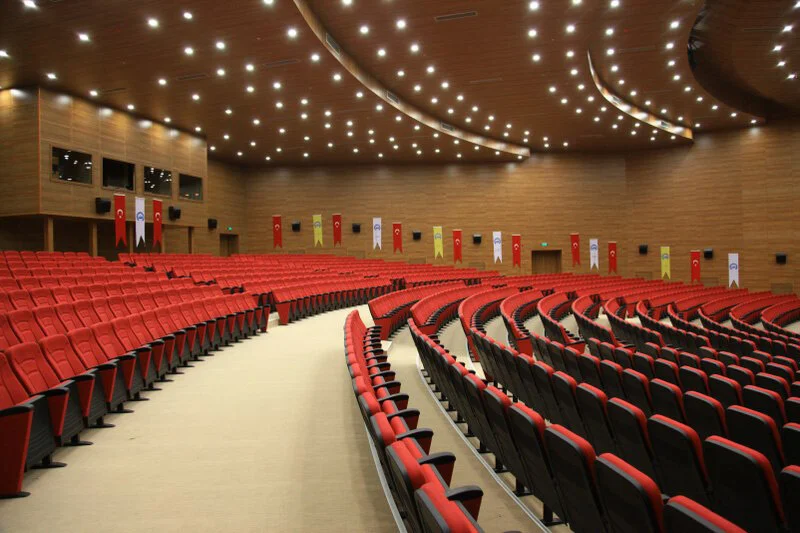When it comes to project based theater seats, the process is not just about choosing chairs that look appealing. It’s about planning, technical alignment with architectural projects, and creating a long-term investment that matches the needs of the venue. Whether you are managing an auditorium, designing a cultural center, or handling procurement for a cinema chain, purchasing theater seating becomes a strategic decision. Let’s dive into the details together and uncover what really matters when making this type of investment.
Table of Contents
Project Based Theater Seats
Professionals often ask: What makes project based theater seats different from standard seating solutions? The answer lies in the flexibility and customization these systems bring. Unlike standard off-the-shelf chairs, project-based solutions are tailored to meet architectural layouts, fire safety regulations, and acoustic requirements. For example, some theaters needed wider row spacing—55 cm (21.6 inches) instead of 50 cm (19.7 inches)—to improve circulation and evacuation planning. This is where project-oriented design steps in.
In recent years, suppliers started offering detailed project based theater seats guide documents, showing seat pitch, anchoring methods, and load resistance. These details help decision-makers align with local building codes while ensuring the audience’s comfort.
Customization in Large Venues
Every project differs. A cinema seating project for a 1,200-seat multiplex in Dubai had completely different requirements compared to a 600-seat municipal theater in Berlin. Fire-rated foams, modular replacement systems, and anti-panic folding mechanisms came into play in one case, while durability against heavy public use was prioritized in another. This level of customization is exactly why project-based purchasing has gained traction among professionals.

Theater Seats: Choosing the Right Type
When we talk about theater seats, it’s easy to focus on appearance. But have you ever asked yourself: How do technical specifications affect the long-term value of theater seating? The answer is straightforward—significantly. Load-bearing capacities, frame structures (steel vs. aluminum), and foam densities change the lifespan of the seating system dramatically.
Materials and Durability
Theater seat materials like injection-molded polypropylene for seat pans or cold-molded polyurethane for cushions are chosen for resilience. High-traffic venues often prefer steel substructures with powder-coated finishes because they resist scratches and moisture. On the other hand, performing arts centers sometimes prioritize luxurious fabrics with acoustic absorption qualities.
Project Theater Seating: Tailored for Each Venue
Project theater seating demands precise planning with architects and acousticians. For instance, sloped floors may require riser-mounting systems, while retractable seating banks are preferred in multi-purpose halls. Professionals in the field know that improper anchoring systems lead to costly repairs within five years.
Installation Insights
During theater seating installation, alignment tolerances often fall below 3 mm (0.11 inches). This might sound insignificant, but such precision ensures visual harmony across rows and prevents uneven load distribution. Have you ever noticed how even a slightly misaligned row distracts the audience visually? That’s why precision during installation is non-negotiable.
Bulk Theater Chairs: The Procurement Advantage
Large-scale projects often rely on bulk theater chairs purchasing strategies. But here’s the real question: Does bulk purchasing compromise on customization? Surprisingly, it doesn’t have to. Many theater seat suppliers provide modular systems where armrests, cup holders, and upholstery options can still be tailored even in high-volume orders.
Wholesale Theater Seating
Suppliers offering wholesale theater seating packages generally provide significant cost benefits, especially for government projects or private cinema chains. However, professionals must carefully check warranty terms, replacement part availability, and after-sales support. Saving upfront is attractive, but ensuring service continuity makes a bigger difference in the long run.
Theater Seat Purchase: Beyond the Price Tag
When planning a theater seat purchase, focusing solely on unit price is a trap many decision-makers fall into. Instead, lifecycle costing paints a clearer picture. Imagine replacing armrest covers every three years versus every ten years—long-term maintenance costs shift the real value of the purchase dramatically.

Budget Theater Seats vs. Premium Solutions
Budget theater seats can be a great option for temporary projects, but high-traffic venues require premium solutions. This raises another common professional question: When does it make sense to invest in premium seating? The answer is whenever durability, maintenance, and reputation of the venue outweigh short-term savings. After all, broken seats during a premiere create both logistical and reputational challenges.
Cinema Seating Project: Planning for Audience Experience
Every cinema seating project goes beyond simply filling space with chairs. Professionals evaluate sightline geometry, acoustic behavior, and even the psychology of audience comfort. For example, staggered rows with 12 cm (4.7 inches) lateral offset improve visibility significantly compared to perfectly aligned seating.
Comfortable Theater Chairs
Comfort becomes a deciding factor in audience return rates. Studies showed that comfortable theater chairs with ergonomic lumbar support increased repeat attendance by up to 18%. In a competitive cinema market, such details translate directly into revenue.
Theater Seating Solutions: Partnering with the Right Supplier
Finding the right theater seating solutions provider changes the outcome of any project. But what should professionals look for? Certifications (such as ISO 9001 for quality systems), references from similar projects, and local after-sales presence make a real difference. A supplier that completed a 2,000-seat opera house project in Paris may bring more reliable experience compared to a newcomer.
Custom Theater Seating
Custom theater seating projects, like VIP lounges in cinemas or municipal council chambers, often require unique designs. Fire-retardant upholstery, embroidered logos, or integrated USB charging ports are just some of the possibilities professionals now demand.
Final Thoughts
Purchasing project based theater seats has always been more than a procurement decision. It’s a long-term investment into audience satisfaction, building safety, and the reputation of the venue. By considering customization, bulk purchasing strategies, technical specifications, and supplier reliability, professionals ensure their projects not only succeed today but remain sustainable for decades. And isn’t that the ultimate goal for any serious project decision-maker?